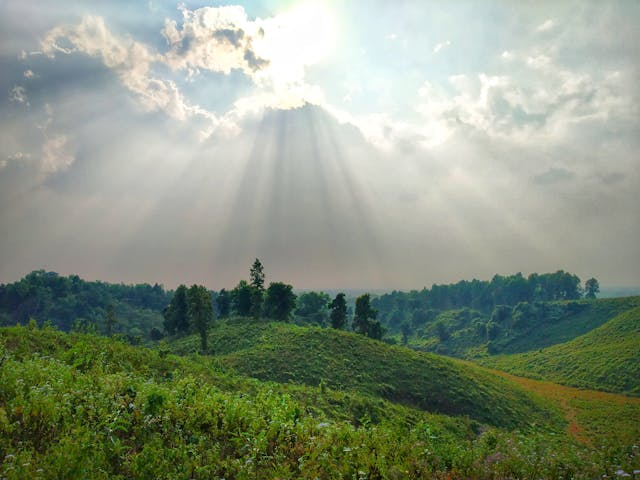
Sherpur
Sherpur is a land of biodiversity and natural beauty. In 1984, Sherpur was separated from the greater Mymensingh district to form its own district. The area spans 1,363.76 square kilometers, and according to the current census, its population is over 1.5 million.
It is known that the areay was part of ancient southwestern border region of the Kamrup kingdom, but it did not have a specific name. However, the capital of the Hindu ruler Dalip Samanta’s kingdom was called Garjaripa. During Emperor Akbar's reign, this region was historically referred to as Dashkahania Bajoo.
In 1869, during the zamindari era, Sherpur Municipality was established. At that time, the southern boundary of the municipality stretched from the Mrigi River to the Jamalpur Ghat, approximately 8 to 9 miles wide. The old name of the Brahmaputra River in this area was Louhitya Sagar. People on both banks of the river often traveled by boat and paid a yearly toll of ten kahan coins to the leaseholder of the ferry. Hence, the area became known as Dashkahania.
At that time, financial transactions and trade were conducted using coins called "kahan." During the era of the Nawabs of Bengal, the last zamindar of the Gazi dynasty, Sher Ali Gazi, captured the Dashkahania region and ruled independently. Later, the area was named Sherpur after Sher Ali Gazi.
During that time, the capital of the Sherpur kingdom was still at Garjaripa. The shrine of Sher Ali Gazi is located in Fakir Bari at Giddha Para in the current Gazirkhamar Union, and his dargah (mausoleum) is in Runi Gaon of Nakla Upazila. During the British and Pakistani periods, the area was called Sherpur Circle.
After Bangladesh's independence, the then-President Bangabandhu Sheikh Mujibur Rahman declared Sherpur as the 61st district. However, due to political changes, this was postponed. Later, in 1979, President Ziaur Rahman declared Sherpur a subdivision, and on February 12, 1984, President Ershad upgraded Sherpur to district status and transformed its five police stations into upazilas. These are Sherpur Sadar, Nakla, Nalitabari, Jhenaigati, and Shreebordi Upazilas.
Sherpur boasts a rich educational history. The first Middle English School was established by the Noyani zamindars. In 1887, it was upgraded to Victoria Academy in honor of Queen Victoria’s Jubilee. Other notable institutions include GKP Memorial School (1918–19), Sherpur Girls’ School (1949), Sherpur College (1964), and Sherpur Women's College, among others. Sherpur also has notable religious institutions, such as the Terabazar Jamia Siddiqia Madrasa, the largest Qawmi madrasa in the district.
Sherpur is home to ancient mosques like the Barduari Mosque in Garjaripa and significant temples, including the Sri Sri Raghunath Jiu Temple and Sri Sri Ma Bhavatarini Temple.
Sherpur is especially famous for its "Chhanar Payesh" (a sweet delicacy made from cottage cheese). On December 5, 2024, Sherpur's Chhanar Payesh received Geographical Indication (GI) recognition. One of the most renowned names for making Chhanar Payesh is ‘Anuradha Mistanno Bhandar,’ located at New Market Mor in Raghunath Bazar, Sherpur town. This establishment has been crafting Chhanar Payesh for five generations. Currently, one kilogram of Chhanar Payesh is sold for 400 BDT.
Apart from this, shops like ‘Premananda Grand Sons,’ ‘Nandagopal Mistanno Bhandar,’ ‘Durga Charan Mistanno Bhandar,’ ‘Ma Bhavatarini Mistanno Bhandar,’ and ‘Charu Sweets,’ located in the areas of Ghosh Patti (Gowal Patti) on Bir Muktijoddha Nijam Uddin Road, as well as in Noyani-Kalir Bazar, also produce and sell Chhanar Payesh.
The notable tourist attractions in Sherpur include: Gajni Obokash, Modhutila Eco Park, Newabari Hill, the shrine of Sher Ali Gazi, the shrine of Jorip Shah, the shrine of Shah Kamal, Bar Duari Mosque, Ghagra Loskor Khan Mosque, Mai Saheba Jame Mosque, Pani Hata Dighi, Noyani Bazar Nat Mandir, Raghunath Jeor Mandir, GK Pilot School, Garjaripa Kalidah Gang’s Dinghy, and the famous rubber dams of Nalitabari and Sreebardi, among others.
